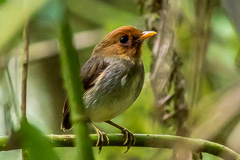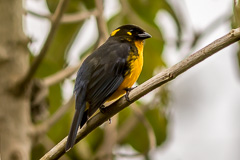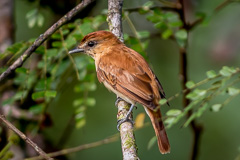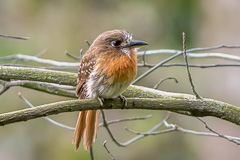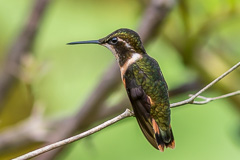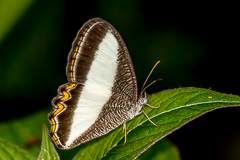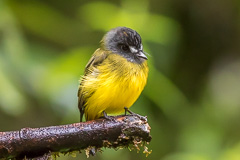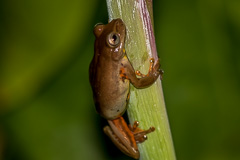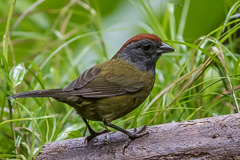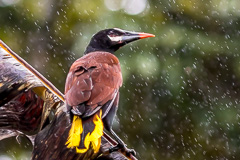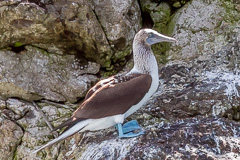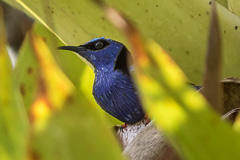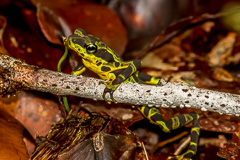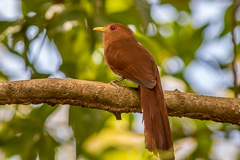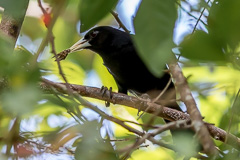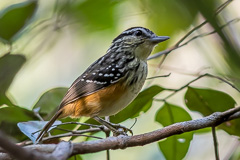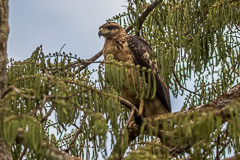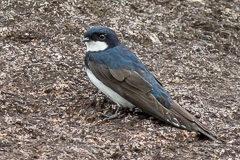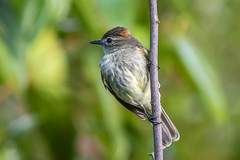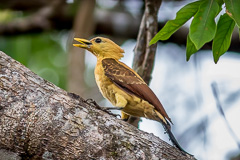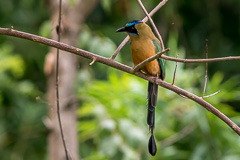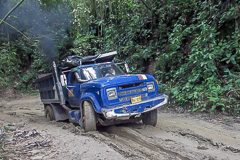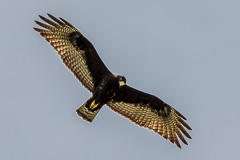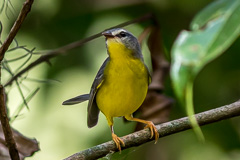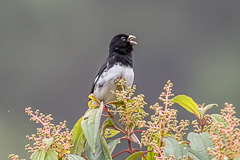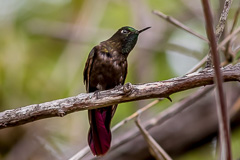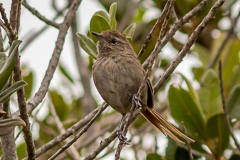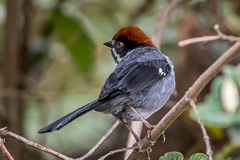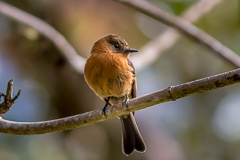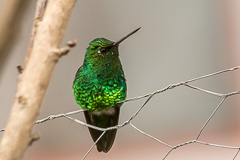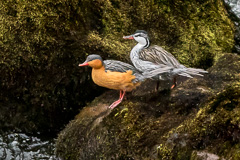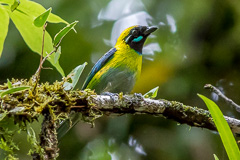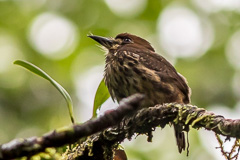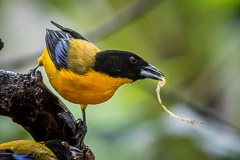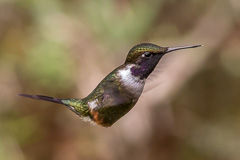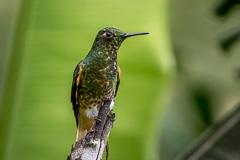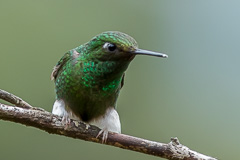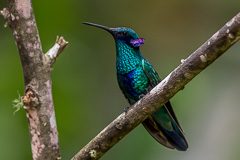Overview
Dates: |
28 Aug - 27 Sep 2016. |
With Ian Harrison, Lee Hung and Mike Danzenbaker. A second Colombia visit following an enjoyable and successful trip in 2015. As most of us had previously birded widely in South America or Colombia the itinerary was based on a selection of more specialised endemics and specialities. This resulted in us birding a fair number of infrequently visited areas well off the usual birding circuit. As last year, guiding and logistics were arranged with Pablo Flores of Multicolor Birding Colombia. The logistics worked well, Pablo and the local guides were great to be with in the field, and we would definitely recommend Multicolor Birding. With Pablo not available the whole four weeks, we birded a week with Johnnier Arango-Bermúdez in the western Andes.
Colombia remains an excellent birding destination with great birds, wild places and friendly people. Travel and security continue to be generally smooth, and this year we were never stopped and checked at any police checkpoint. With the signing of the peace deal between the government and FARC, unfortunately not passing a national referendum, Colombia will no doubt grow in popularity with tourists and birders alike. This trip did though suffer more than its fair share of logistical issues, due mostly to weather. Additionally, despite considerable effort, we struggled to find, and missed, a number of expected targets; suggesting September may not the best time to bird Colombia. On the positive side we encountered almost no other birders and had the lodges at Santa Marta and Perijá to ourselves, as most birders visit during the drier period of January to March.
Itinerary
26-27 Aug. A long journey flying Chiang Mai - Bangkok - Amsterdam - Bogotá - Pereira on Bangkok Airways, KLM and Avianca, that passed smoothly and arrived on time at 19:30 in Pereira, amazingly complete with baggage despite only a 50 minute connection in Amsterdam. Now on totally the opposite side of the world with a 12 hour time change. Collected at the airport and transported the one hour to Otún, where met up with Johnnier, our guide for the first week, plus Mike and Lee who'd arrived a couple of days earlier in order to bird Rio Blanco and Paramo Ruiz. Overnight at Otún reserve.
Otún Reserve Training Centre This sizeable lodge just inside the Otún Reserve runs as a training centre for park staff and other environmental groups. The place has a feeling of university and school dinners about it, as meal times are fixed and you queue up in front of the servers. The rooms were simple but fine, clean and with hot showers. No internet. |
28 Aug. Cool but dry early morning. An 05:30 breakfast, after which a local driver was supposed to transport us along the main track inside the reserve. As he didn't turn up and was uncontactable we simply walked, picking up our first birds of the trip - Cauca Guan, Red-ruffed Fruit Crow, Blue-necked Tanager, Three-striped Warbler and the like. When he eventually deigned to turn up after 08:00, probably on account of a hangover from the previous evening, the rest of the morning spent on a drive/walk along the whole six kilometres of the main track, finding the much sought after Hooded Antpitta plus Rusty-winged Barbtail, Booted Racket-tail, Multicoloured Tanager and poor views of disappearing Chestnut Wood Quail. As the morning progressed and the heat rose, many stunning butterflies were in evidence. With today being a Sunday a notable downside was the number of weekend off-road cyclists ploughing the route through the reserve - a good point to remember in future. Returned to the lodge for lunch, after which it immediately started to rain - an uncanny coincidence that was to figure strongly in the coming days. An hour passed with us birding from the cover of various buildings, when at 14:30 the rain ceased and we took to the forest trails behind the lodge, primarily hoping for Chestnut Wood Quail. Despite the excellent-looking forest, overcast skies and cool conditions kept bird activity to almost zero. Hard work, with the best species being Northern Chestnut-breasted Wren heard. The final couple of hours of daylight spent walking the main track again, with Colombian Screech Owl heard at dusk together with a couple of Rufous-bellied Nighthawk circling. Overnight again at Otún.
29 Aug. With only an hour of birding available we opted for a pre-dawn start, hearing Colombian Screech Owl but again being unsuccessful with Chestnut Wood Quail. Drove to Pereira and met up with Ian having just arrived from Bogotá, before proceeding on the dirt mountain roads toward Los Nevados National Park searching for Fuertes's Parrot, one of our main trip targets.
This critically endangered parrot is known from a couple of localities only, with a seriously low number of individuals remaining. Few birders try for this parrot due to the necessity of dedicating a day from the itinerary for basically one species. In cool, cloudy conditions, the morning passed with us walking the road scanning distant hillsides for perched or flying parrots. During this time we encountered Andean Guan, Black-chested Buzzard-Eagle, Band-tailed Pigeon, Tourmaline Sunangel, Purple-backed Thornbill, Buff-winged Starfrontlet, Lacrimose Mountain Tanager, Sword-billed Hummingbird, Golden-plumed Parakeet, White-capped Parrot, Black-headed Hemispingus and Crowned Chat-Tyrant. |
Then, just on noon, a distant, single, perched Fuertes's Parrot was found, but flushed by a passing truck before anyone had decent views. Figuring if one parrot was present maybe others were nearby, we made this a lunch stop and were rewarded with two other views of flying individuals. A sizeable group of Grey-breasted Mountain Toucan kept us occupied in between time. The early afternoon spent walking, between spots of rain, in the reverse direction, encountering Dusky Piha, Bar-bellied Woodpecker, Brown-bellied Swallow, Hooded Mountain Tanager and Brown-breasted Chat-Tyrant.
Hotel Castilla Real, Pereira Situated in the centre of Pereira. A good all-round hotel with comfortable rooms, fast internet and excellent showers. The restaurant was OK, although they made a mess of the orders in several ways, that didn't exactly seem like a once-off thing. |
At one lookout we lucked on to a passing group of 16 Fuertes's Parrot, that again perched only distantly. With cloud descending and temperatures dropping we left at 15:00 for the two hour return to Pereira, with an overnight at the Hotel Castilla Real in town. |
30 Aug. An 05:00 departure to Apia, through some heavy rain, where we arrived at the town square by 08:30, stopping for a quick breakfast at the first restaurant to open. Next stop, an area of shade coffee plantations on the edge of town where, with the rain just about easing, a very productive, short birding session found at least four Turquoise Dacnis, Moustached Puffbird, Bronze-winged Parrot, Parker's Antbird, Barred Becard, Cinnamon Becard, White-winged Becard, Guira Tanager and Yellow-backed Oriole. Then a further 90 minutes to Montezuma where the lodge and staff looked unchanged from last year and it felt good to be back, especially as it was not actually raining. Hummingbirds on the feeders included White-necked Jacobin, Black-throated Mango, Violet-tailed Sylph, Velvet-purple Coronet, Collared Inca, Rufous-gaped Hillstar, Empress Brilliant, Green-crowned Brilliant, Purple-throated Woodstar, Western Emerald, Andean Emerald, Steely-vented Hummingbird and Rufous-tailed Hummingbird. Following lunch, straight up the hill on the much improved road to around 2,000 metres, from where we walked back to lodge. As our memories of last year were of this being the worst road we travelled on, a massive surprise that the road had been regraded last December. The first hour here was fantastic; sunny and warm with excellent bird activity, gaining us Star-chested Treerunner, Cinnamon Flycatcher, Orange-breasted Fruiteater, Gold-ringed Tanager, Glistening-green Tanager, Indigo Flowerpiercer and Choco Vireo heard. This unfortunately came to an abrupt end with low cloud moving in killing almost all bird activity. So a slow remainder of the day, with a single Choco Vireo and Crimson-rumped Toucanet late afternoon after much effort. Back to lodge by 18:00 with rain and drizzle running into the whole evening. A moth bonanza after dark with well over 100 species simply around the dining area. |
Montezuma Lodge, Tatamá National Park Given the locality, you'd not wish to stay anywhere else. Right on the forest edge and run as an eco-lodge. A great place. Basic but comfortable. New rooms that were under construction last year now finished. Warm showers, no WiFi, mobile signal available around the restaurant area only, food fine and very helpful staff. Laundry possible but drying can be difficult in the almost constantly damp conditions. |
31 Aug. An early start, heading up the mountain at 04:50, stopping en route for another attempt at Colombian Screech Owl and this time having great views. A short distance farther, at dawn, a pair of Beautiful Jay gave us a runaround. Sunrise at the summit was cool and overcast with high cloud, where we found Munchique Wood Wren but alas no Chestnut-bellied Flowerpiercer, presumably on account of the lack of flowers. We spent the day in a slow walk down the mountain in overcast conditions, but only a few periods of fog, so generally clear and cool - almost perfect birding weather. Few flocks and the birding generally slow but a good selection of quality species, many picked out by voice by Johnnier.
Highlight was certainly Lanceolated Monklet, but others included Bicoloured Antvireo, White-faced Nunbird, Powerful Woodpecker, Star-chested Treerunner, Rufous Spinetail, Black-and-gold Tanager, Gold-ringed Tanager, Purplish-mantled Tanager and Rufous-throated Tanager. |
Additionally Choco Tapaculo, Choco Tyrannulet and Cloud-forest Pygmy Owl all heard. Back around 17:30 when rain started. A Boettger's Colombian Tree Frog Dendropsophus columbianus after dark near the restaurant.
1 Sep. Heavy rain all night, still hadn't eased by 05:30 when we met for coffee. Undeterred, we drove up hill anyway on the misplaced theory we could drive above the rain. Still wet at 1,700 metres, so descended to take breakfast in one of the shelters where Olive Finch are well accustomed to feeding on crumbs from birders sheltering from the rain - a common event at Montezuma. A walk downward for an hour, with the rain easing somewhat, gave us Cloud-forest Pygmy Owl, Ashy-headed Tyrannulet and Yellow-breasted Antwren. Packed and left by 10:00 for the 90 minute drive to Gito where we walked a short distance along the river, bumping into a group of a dozen Baudo Oropendola that took off shortly after. This proved to be somewhat fortuitous as in the next hour they failed to return. Lunch in a nearby town then on to Quibdó which should have been a three hour drive, but turned into a six hour nightmare. Having been assured the road was open, after an hour we ran into a two hour military road closure, reasons for which we could not ascertain. Next we encountered 50 kilometres of continuous roadworks and landslides with finally a festival in Tado town with roads closed by police and traffic at a standstill. Dropped Johnnier and picked up Pablo en route, and finally arrived in Quibdó town, where we spent 30 minutes navigating to the centre and our hotel. Quibdó, the capital city of the Chocó region, has absolutely nothing to recommend it. |
Hotel Quibdó Plaza, Quibdó Smack in the middle of noisy Quibdó city, so ask for a room away from the front. Several restaurants across the street, WiFi passable, rooms on the small size, with the usual Colombian beds made for midgets and cold shower only. Not particulars recommended but probably the best place to stay in town, so like it and lump it. |
Noisy, dirty, chaotic and best avoided. Our only reason to stay was to take the first flight out the following morning. As an aside, it is notable when travelling throughout the Chocó region of western Colombia, that the population consists almost entirely of Afro-Colombians that give the region a totally African feel, with the towns and villages reminiscent of much of sub-Saharan Africa. The origins of these people date back to the slave trade in the region starting in the 1500's. |
2 Sep. Overnight rain had eased by the time we left for the airport, from where we took the 08:00 flight to Nuquí that left an hour late. The 20 minute, 80 kilometre journey passed over apparently intact forest that looked really ripe for exploratory birding. With few villages and no roads in the area, access would be by river only. The 18 seater plane used on this route had no overhead luggage storage and severe restrictions on carry-on baggage, that caused us some grief at check-in.
At Nuquí we simply dumped the luggage in a wheelbarrow, walked to the jetty, then took a pre-arranged boat, along the coast, the 40 kilometres to Utría National Park lodge. Fortunately the sea was calm, allowing birding along the way. Most interesting were a set of offshore rock stacks that had several Surfbird - a new Colombian species for Pablo. Other species encountered included nesting Brown Booby and Blue-footed Booby as well as Common Black Hawk and Humpback Whale. We arrived at Utría by 11:00. The location is stunning, with the lodge situated on the beach of a beautiful bay, backed with mangrove and forested hills. |
Having dumped our bags, immediately took off for a walk along the excellently constructed boardwalk that runs from the lodge for 800 metres into the mangrove, along which several of our target species could, in theory, be found. As expected, given the heat and time of day, activity was rather subdued, with only Green-crowned Woodnymph, Purple-throated Fruit Crow, King Vulture and Blue-chested Hummingbird. Following lunch and a short siesta, set out again at 15:00, walking the short path running southward along the lodge area. Saw Great Antshrike and heard both Uniform Crake and Brown Wood Rail though neither had any interest in showing themselves. Returned again to the mangrove boardwalk where with the last two hours of light concentrated on searching for Baudo Guan that allegedly roosts, though not found. We did however have Dusky Pigeon, Yellow-crowned Night Heron, Lesser Swallow-tailed Swift, White-vented Plumeleteer, Pied Puffbird, Choco Toucan, Great Green Macaw, White-vented Euphonia and heard Choco Tinamou.
Utría National Natural Park Lodge A great place to get away form it all. Situated on the beach an hour's boat ride from either Nuquí or El Valle. Amazingly, despite its remote location has WiFi and a weak mobile signal after a walk down the beach. Simple but comfortable with cold showers and no fan, though temperatures drop pleasantly at night. Low power electricity is provided by a mixture of solar and generator. Can cater for 32 guests but only a few rooms are self-contained with private bathrooms. Food simple but good given the location, providing you like fish, rice and salad in different forms for lunch and dinner every day. Bread and eggs for breakfast. Highly recommended. Would be a great place to stay a week to both relax and explore. |
3 Sep. Breakfast at 05:30 then, taking advantage of the high tide, took a boat five kilometres to the north to the start of the El Valle - Utría Trail. An initial steep ascent for a couple of hundred metres after which the trail generally levels out, with us exploring it the whole morning till 13:00, during which we met Balmes, an enthusiastic local bird guide. Birding was pretty slow-going, during which Streak-chested Antpitta gave us the runaround for over an hour without success. Other species such as Black-tipped Cotinga, Black-breasted Puffbird, Spotted Antbird, Choco Sirystes, Yellow-winged Flatbill and Black-headed Tody-Flycatcher were seen. On return to the start of the trail, as the tide had now dropped, a 400 metre walk through the mangroves was required to reach a spot with water deep enough for the boatman to pick us up.
Lunch, rest and out again at 15:00 for a repeat of yesterday afternoon trying for specialities around the lodge. Again both Uniform Crake and Brown Wood Rail heard but stubbornly refusing to be seen. Around 16:00 the rain that had been threatening all day finally arrived with us taking shelter for 30 minutes. As it eased, we walked back to the accommodation with, again, a second Brown Wood Rail so close but so far. Just as we were to start on the boardwalk the rain descended again, delaying us a further half hour. In the last 30 minutes of light we walked the boardwalk - hearing Baudo Guan, but little else.
4 Sep. One of our wettest days of the trip. Following thunder and showers all night, very overcast at daybreak, but at least dry. Out at first light to try for missing targets. After a quick coffee we headed to check the swampy areas around the lodge where rails and crakes sometimes feed at first light. Again both species heard only - this was becoming decidedly frustrating. Creeping up to the compost heap behind the kitchen we were surprised by two larger brown-jobs digging around, that initially had our pulse racing for Brown Wood Rail with their brown backs and grey tops to the heads, but disappointingly turned out to be Grey-headed Dove. A short walk on the boardwalk gave us further excitement with two guans, that disappointedly turned out to be the uncommon Crested Guan rather than the more expected Baudo Guan. Following breakfast we again took the boat to the El Valle - Utría Trail arriving by 08:30. This morning could only be described as birdless in the extreme, and despite much effort very few species recorded with Golden-crowned Spadebill and Spot-crowned Antvireo the pick of the bunch as well as a Neotropical Otter glimpsed. Today the forest just seemed devoid of birds. Then to make things even more enjoyable the heavens opened and we ended up cowering under umbrellas for an hour. The downpour had still not stopped by the time we needed to return to the boat, with the trail more like walking up a small stream followed by 400 metres of wet mangrove. Lovely. Light rain during the return boat ride turned heavy and continued till 15:00 when it finally eased and we decided to try the boardwalk. En route a calling Uniform Crake again refused to appear. The rest of the afternoon spent studying hummingbirds from the boardwalk with eventually one of our targets, Humboldt's Sapphire, found as well as Rufous-tailed Hummingbird, Blue-chested Hummingbird, Red-legged Honeycreeper, White-vented Plumeleteer, White-whiskered Hermit and Green-crowned Woodnymph. And finally a Brown Wood Rail put in an appearance at the back on the mangroves - at the eleventh hour to all round relief. At dusk Baudo Guan heard distantly. All in all a wet and damp day rescued with a couple of excellent birds. A third night at Utría.
5 Sep. Showers continued overnight but cleared by early morning to give a beautiful day of mixed cloud and sun. A pre-dawn start along the boardwalk with flashlights, hoping for crakes but again no joy. Continued on the boardwalk hoping for Baudo Guan but again nothing.
Back to lodge area to hunt for crakes, with again birds calling close by. After breakfast we took a boat across the bay to walk the Attalea Trail that runs for a couple of kilometres across the headland to the coast the other side. In our few hours here we birded the first kilometre of this trail, much of which is simply walking up a river bed, so rubber boots were essential. Again very quiet initially, but persistence paid off with a pair of Sapayoa, Rufescent Tiger Heron, Stripe-throated Hermit, Tooth-billed Hummingbird and Tawny-faced Gnatwren. Also a snazzy-looking toad, later identified as Condoto Stubfoot Toad Atelopus spurrelli. |
On return to the beach we had a 40 minute wait as the boatman simply forgot to collect us. Left Utría at 14:10 for the 40 minute boat ride northward to El Valle. Some delays ensued trying to sort out rooms at the pre-booked El Almejal and it was eventually past 16:00 when we squeezed into a couple of motorcycle taxis for the short ride out along the semi-forested road toward Bahia Solano, with our last hour spent scanning from a hilltop for parrots. Sightings included Blue-headed Parrot, Rose-faced Parrot, Mealy Amazon and Red-lored Parrot. A major surprise was a single Baudo Oropendola as well as two Black-tipped Cotinga and a Blue Cotinga.
6 Sep. Heavy rain overnight clearing by morning. Set off in motorcycle taxis through town, crossing the rickety bridge, to the start of the trail to Utría National Park - effectively the opposite end of the Utría - El Valle Trail we'd been on a few days previously. Reasonable weather and we spent the morning doing the first five kilometres of the trail. Our chief target was Stub-tailed Antbird of which we didn't get a sniff, although we did obtain good views of Streak-chested Antpitta, brief views Tawny-faced Quail, plus a selection of commoner species.
El Almejal, El Valle Strange room design more for families with double and twin rooms sharing bathroom facilities with open access between the rooms. Good restaurant that provided an early take-away breakfast and coffee at 05:30. Situated on a black sand beach with good sunsets; at least when we there. No WiFi. Cold showers only, in common with all places in lowlands of Colombia. Cool at night. Comfortable. Playa Alegre, El Valle The adjacent accommodation to El Almejal, of similar standard with some newer rooms. Cold showers and no WiFi. We didn't eat at the restaurant as already booked at the El Almejal. |
By 11:00 rain started so it was a long walk back, with the rain continuing, sometimes heavy, until 14:00. Due to further confusion with room availability two of us ended up changing rooms and two others moving into accommodation next door at Playa Alegre. Back out again on motorcycle taxis to the same hilltop we'd scanned from yesterday. Much improved weather, and with the sun out pretty hot and humid. Parrot species much the same as yesterday, and after an hour we decided to take a short drive to bird the road a little farther toward Bahia Solano, that produced the sought after Spot-crowned Barbet. A final 45 minutes on the hilltop with more distant views of Rose-faced Parrot, several stunning King Vulture and better views of Blue-headed Parrot, Red-lored Parrot and Mealy Amazon. Some chiggers here, as we later found out. |
7 Sep. Back along the road to Bahia Solano, where we spent three hours along a trial to the east toward an Indian settlement, though much the same species as previously. Slate-coloured Seedeater heard. Rain started at 10:00 after which we continued the ten kilometres on the dirt road to Bahia Solano Airport and checked in for the 13:15 flight to Quibdó, only to be informed of an hour's delay due to poor weather in Medellin interrupting all regional flights. Two hours later and we were informed that the flight had been cancelled. Quite a disaster, with the only solution being to charter a plane from/to Quibdó for over $1,000 in order to get to Bogotá and our flight to Inírida the following day. Ouch! And to add insult to injury the airport still demanded we pay the airport passenger tax! Our charter arrived at 16:30, which together with the delayed flight to Bogotá, had us arriving there by 19:30, consequently with a late arrival at the Grace Hotel in town.
Grace Hotel, Bogotá An apartment type hotel within Bogotá city. Noisy on the first level opposite reception. Good WiFi. Several restaurants nearby. Reasonably quiet location about 30 minutes from the airport. Recommended. |
The upshot of this delay and rushed connection was that we missed the possibility to look for Sooty-capped Puffbird near Quibdó. One to add to the list for next time. Our first hot shower for a while and a trip around the corner to the local pizza joint at which we arrived just before the 21:00 closing time. |
8 Sep. A relative lie-in till 06:00 when we headed back to the airport for the 09:15 flight to Puerto Inírida, that was only half an hour delayed. The aircraft used on this route, being an Embraer, gave the usual hand-baggage headaches with almost no hand baggage space and a five kilogram restriction. That putting a five kilogram camera and lens around your neck does not contribute to the hand baggage limit is a bit of a joke, but a useful ploy. Arrived at Puerto Inírida at 11:00 when, with impeccable timing, it promptly started raining. Note that yellow fever vaccination certificates were being checked on arrival and vaccination offered to those without certificates. Interestingly, Inírida had that Amazonian frontier town feeling about it, bringing back memories of our time last year in Mitú. This is a place for intrepid birders, that to date few have visited. During our six days we found many species as yet unrecorded from the area, several with large range extensions, as well as Yellow-crowned Elaenia - a species new to Colombia. Mitú does however have a higher diversity due to its range of forest types, whereas Inírida only really has white-sand and varzea forest types. A short drive to the Hotel Orinoco Real followed by a quick lunch, then down to the river from where we took our boat with Milton, our local boatman cum Mr. Fixit, into the varzea forest a few kilometres upstream. Varzea Schiffornis heard, Blackish-grey Antshrike and Long-billed Woodcreeper. Late afternoon several Boto, also known as Amazon River Dolphin, and Sand-coloured Nighthawk. By evening, not feeling at all well so crashed out with a fever and diarrhoea.
Hotel Orinoco Real, Puerto Inírida Simple and comfortable. Rooms with either fan or A/C. Until recently no WiFi, but during our stay we had WiFi half the time. Some noise from nearby bars at night, so ask for a room away from the front. Cold showers. No restaurant, but several places to eat in town. No doubt the best place to stay in this small Amazonian town. |
9 Sep. Being farther east, the sun rises earlier at Inírida, so we left the hotel at 05:30 and out again on the river - this time downstream about ten kilometres where we investigated various channels into the varzea. Having recovered somewhat from the fever there should have been the four of us. However, the same problems had struck Mike, so we were reduced to the two of us. Luck was with us this morning with Varzea Schiffornis, Ringed Woodpecker, Amazonian Streaked Antwren, Solitary Cacique, Velvet-fronted Grackle, Little Cuckoo, Dark-billed Cuckoo, Plain-capped Spinetail, Rusty-backed Spinetail and Black-capped Donacobius; the later three well out of known range. Although rain looked ominous it didn't materialise, and by 11:00 with the day becoming very hot we returned to the hotel. After lunch took a taxi van a few kilometers to an area of white sand forest where the much sought after Yapacana Antbird was found stealthily creeping through dense riverside vegetation as well as Citron-bellied Attila, Imeri Warbling Antbird and Amazonian Antshrike. 10 Sep. Dry overnight, but with rain commencing just before 05:20 when we drove southeast from town to bird an area of flooded white sand forest. As still raining on our arrival we used a local restaurant in the village as a shelter to waste three hours till about 09:00 when it finally eased enough for us to at least bird with umbrellas. A further three hours in the rain were quite productive, with Lined Seedeater, Ruddy-breasted Seedeater, White-naped Seedeater, Plain-crowned Elaenia, Wedge-tailed Grass Finch, Red-shouldered Tanager and Plumbeous Euphonia heard. Incredibly, at 12:30 when we left it promptly stopped raining. After lunch in town we headed out again on the river, in much improved weather, back to same area as yesterday morning with similar birds, but the addition of Yellow-chinned Spinetail another significant range extension. At dusk we looked, unsuccessfully, for Amazonian Umbrellabird. |
11 Sep. A long, all day trip travelling 70 kilometres, 90 minutes, upriver to a picturesque area of small tepuis, also noted for its bird life. Started with a short stop a few kilometres prior to explore a wide track used for distribution of goods to the interior. Apparently this track can be followed for 100 kilometres and no doubt has massive birding potential. However, in the interests of time and the rising heat of the day we only managed the first kilometre or so. Chasing a mystery call for 45 minutes turned out to be simply Helmeted Pygmy-Tyrant.
Other species included White-browed Purpletuft, Brown-headed Greenlet, Orinoco Piculet, Yellow-throated Flycatcher, Sulphury Flycatcher, Green Kingfisher, Slender-footed Tyrannulet, Ruby-topaz Hummingbird and White-chinned Sapphire. At 11:00 continued to the tepuis themselves, climbing part way up for the splendid view. Stayed here a couple of hours with Black-collared Swallow, Pied Plover, White-winged Swallow and decent views of Plumbeous Euphonia at last. Headed back toward Inírida for an hour and then explored a tributary for the last couple of hours of the day finding Green-tailed Jacamar, Buff-throated Woodcreeper and Golden-olive Woodpecker. |
12 Sep. A return to the white sand forest where we'd had the wet start two days previously. With much improved weather we ventured, with a local guide, on a maze of agricultural and hunting trails the opposite side of the village, and an area not previously birded. Slow as usual for predominantly white sand forest, but we slowly built a good list - Spangled Cotinga, Rufous-tailed Flatbill, Yellow-backed Tanager, Black Manakin, Green-tailed Goldenthroat and Southern White-fringed Antwren plus a tiny hummingbird that must have been something highly interesting such as a coquette, that promptly disappeared. Very hot by 11:00, so returned to town, took lunch, then out again on the boat by 15:00 finding Pale-tailed Barbthroat, Crimson Masked Tanager, Large-billed Tern, Muscovy Duck and a distant Horned Screamer heard.
13 Sep. A totally bum-numbing day with 12 hours on the boat. Although a boat is absolutely necessary to access the majority of the habitat at Inírida, sitting in one for hours can be extremely trying. As a rarity appears behind you, drifting past, it's either a case of craning the neck or standing up and take a risk of falling overboard; especially high if everyone panics and does the same. Out early at 05:30 on the river in yet another attempt at locating Rose-breasted Chat, that we'd now been looking for for five days.
Amazingly at mid morning we heard the distinctive song, and eventually had reasonable views of an individual close overhead. So engrossed were we by the morning's birding we opted to skip lunch and remain out exploring tributaries. An additional number of targets were found such as Curve-billed Scythebill, Spot-winged Antshrike, Dot-backed Antbird and Speckled Spinetail, together with another pair of Orinoco Softtail. Back to town, with what felt like a square bum, by 17:30. In summary, Inírida is a tough place to bird, with about 220 species recorded in our time here, indicating low species diversity and density. At least six days are required and we left with a long list of targets known from the area, but unseen. However, the effort was well worth while with several excellent and difficult species seen, plus it's great to bird at a site few birders visit and is totally under watched and under recorded. 14 Sep. A long and hectic day. Our fourth morning in a row of good weather, and out by 05:15 to a different area of white sand forest, past the airport, near the local dump. Black Manakin, White-naped Seedeater, Rufous-crowned Elaenia, White-browed Purpletuft and Green-tailed Goldenthroat. Back to the hotel and on to the boat for a final run from 08:45 to 12:15 finding Curve-billed Scythebill, Little Woodpecker, Plain-capped Spinetail, Speckled Spinetail, Velvet-fronted Grackle, Cream-coloured Woodpecker and Ringed Woodpecker briefly. |
A quick pack and back to airport. Check-in was much smoother this time as we'd prepared for the hand-baggage restrictions. Another dash back to town for lunch, there being none at the airport, then return to the airport, with flight leaving on time but late arriving in Bogotá due to air traffic congestion. After a rush to the Avianca terminal for our flight to Santa Marta, a further delay due to insufficient staff working at the check-in counters. Made the Santa Marta flight just in time, with a sandwich dinner on the run, to arrive Santa Marta at 20:15. Finished the day with a 45 minute drive to Minca where overnight at the pleasant Minca Hotel.
Minca Hotel, Minca A nice place in an old property on the edge of Minca. Small but comfortable rooms with hot shower and WiFi. Has a number of hummingbird feeders on the restaurant balcony. Recommended. ProAves El Dorado This very comfortable lodge, owned and operated by ProAves has been operational since 2011. No phone coverage, but slow internet was working. Great food, especially the soups prepared by the local staff. Rooms with really hot, scalding, showers. The garden is decked out with hummingbird feeders as well as a couple of grain dispensers that attract guans and occasionally wood-quail. Highly recommended, though not cheap. Staying at El Dorado is realistically the only option for birders wishing to bird the upper altitudes of Santa Marta early morning. The alternative, to stay in Minca, requires a two hour plus journey each way, especially now with the road in such poor condition. |
15 Sep. Started with a short drive up the mountain to search, successfully, for Rufous-breasted Wren and Rufous-and-white Wren, coming into contact with several feeding flocks in the process, including Whooping Motmot. |
Quite some traffic using the road, as farther into the mountain construction and renovation underway. Trucks bogged down in the now horrendously muddy road meant we arrived later than planned at the lodge. Lunch followed by rain that kept us at the lodge all afternoon, and wet into the evening. The two most hoped-for birds around the lodge - Santa Marta Woodstar and Black-fronted Wood-Quail - unfortunately failed to materialise. Given the time of year, the feeders attracted fewer species of hummingbird, with the best being White-tailed Starfrontlet and Lazuline Sabrewing. After dark a Kinkaju on feeders emptying the contents. No owling as decidedly damp and miserable. 16 Sep. Our earliest start of the trip at 04:10 for a quick try for Santa Marta Screech Owl, that amazingly was seen at eye level and close range almost immediately - totally contrary to last year's hard search and glimpse of a bird in the canopy. Then at 04:30 we departed to drive the hour to the top of the San Lorenzo Ridge, arriving just before sunrise, with Stygian Owl en route. As Santa Marta was a repeat visit from last year one of our main targets was Santa Marta Parakeet, missed previously and alledgedly often present around the summit at dawn. However, this was not the case today, though a good selection such as Paramo Seedeater, Santa Marta Bush Tyrant, Streak-capped Spinetail, Santa Marta Warbler, Scaly-naped Parrot, Brown-rumped Tapaculo, Santa Marta Brushfinch and Santa Marta Mountain Tanager. |
We persevered around the top until about 11:00 hunting for the parakeet, after which we walked slowly downhill two to three kilometres hearing them distantly. A further drive down took us in to the area we reckoned the birds had been calling from, but our search was cut short by the onset of rain, so retreated to the vehicles for a couple of hours until 15:30 when the weather cleared and late afternoon sun came through. Flying parrots included Red-billed Parrot and Scarlet-fronted Parakeet, but two distantly perched birds proved be Santa Marta Parakeet once we'd returned to the lodge and checked better literature, the illustration in the most recent Colombia guide being decidedly poor - so another eleventh hour bird success.
17 Sep. Based on feedback from the lodge staff, Santa Marta Woodstar was supposed to be reliable early mornings around Palo Alto, a few kilometres below the lodge. So with our last morning we split our efforts, with two staying around the lodge waiting for Black-fronted Wood Quail and two descending to Palo Alto to stake out the woodstar. Needless to say, Murphy's Law prevailed and those seeking the woodstar were gripped off by a female Santa Marta Woodstar at the lodge. After four hours, with Southern Yellow Grosbeak the highlight, we gave up and all headed downhill in a successful search for Coopman's Tyrannulet.
Hampton Hotel, Valledupar Plush place in the middle of the Valledupar city, run by the Hilton Group. We'd booked here as we'd grabbed a cheap deal for little more than the price of the usual shoddy hotel in Manaure used en route to Perijá. Good WiFi and comfortable rooms as expected from a top class hotel. The only issue was having reception on the fifth floor rather than at ground level, that made checking-in a pain with the baggage. |
On passing Minca, we dropped in to the Minca Hotel for coffee and a look at the hummingbird feeders, adding Pale-bellied Hermit and a surfeit of Steely-vented Hummingbird and Rufous-tailed Hummingbird. A five hour drive through the hot lowlands to Valledupar where we checked-in to the swanky Hampton Hotel, but ate dinner in the adjacent shopping mall food court. |
18 Sep. Headed out of town and drove the hour to Manaure town where we explored an adjacent valley for the critically endangered Perija Brushfinch, a pair of which found plus Black-fronted Brushfinch, Black-mandibled Toucan, Orange-chinned Parakeet, Streaked Xenops, Golden-crowned Warbler and Grey-throated Warbler. After about three hours, continued the two plus hour drive up to the ProAves Chamicero Reserve and lodge, stopping to bird along the way, with Perija Tapaculo, Montane Woodcreeper, Rufous Spinetail, Slaty-capped Flycatcher, Golden-breasted Fruiteater and Inca Jay. Lunch at the small lodge, situated at 2,600 metres and decidedly on the cooler side. On the feeders were Tyrian Metaltail, Sparkling Violetear, Lesser Violetear, Mountain Velvetbreast and Longuemare's Sunangel. Mid afternoon we birded the road below the lodge, finding Coppery Emerald and Black-and-white Seedeater. From our drive through the Perijá mountains, only minute fragments of native habitat now seem to remain, with clearly the bird life here in deep trouble. The small Chamicero de Perijá Reserve initiated by ProAves is the only protected forest on the Colombian side of these mountains. The outlook looks really bleak. |
ProAves Chamicero Reserve Lodge, Perijá One of the newer ProAves lodges, this comfortable lodge has been operational for a couple of years. Rather small rooms. Located close to the paramo and perched high on a hillside with commanding views and remnant forest nearby. Given its location, hardly surprisingly no internet and no mains electricity, but power provided by a small generator, and really great, hot showers that are very welcome at this altitude. Would be a great place to stay longer and explore the devastated Perijá mountains. |
19 Sep. A 20 minute drive to the edge of the paramo for daybreak at 05:30. Unexpectedly, somewhat cloudy and quite windy that made finding Perija Thistletail tricky. However, with that under the belt we drove farther into the paramo in search of hummingbirds. The strong winds made finding perched hummingbirds difficult, but after an hour or so we had good views of Perija Metaltail, following which we similarly struggled to obtain views of Stripe-backed Canastero. Then followed some unexpected success in seeing the distinctive Perijá form of Perija Antpitta. Other birds on the paramo were Longuemare's Sunangel, Perija Tapaculo, Black Flowerpiercer, Brown-bellied Swallow and Red-crested Cotinga. Late morning we walked the track back to the lodge hunting for the local form of Golden-bellied Starfrontlet, another likely split, without success, though did see Spectacled Tyrannulet and Masked Trogon. After a late lunch, we walked below the lodge in a continued search for the starfrontlet, again drawing a blank. 20 Sep. Another early start with an 04:30 breakfast and leaving at 05:00 to drive 30 minutes downhill to try for Klages's Antbird, but nothing found. With time pressing for us to leave for Valledupar airport we made a couple of short stops in the lowlands resulting in several new species for the trip - Stripe-backed Wren, Trinidad Euphonia, Caribbean Hornero and Ferrruginous Pygmy Owl. |
Took the Avianca flight to Bogotá, arriving in good time for the 16:30 connection to Popayán for three of us, and with Ian departing to the UK. At Popayán, we were reunited with Juan, one of our drivers from last year's trip, who's also an up and coming birder with sharp eyes. Popayán, also known as the white city due to its whitewashed colonial buildings, is one of Colombia's popular tourist towns. Although small, at this time of the evening traffic was heavy and congested and it took quite some time to drive the short distance to the centre and the Hotel Plazuela.
Hotel Plazuela, Popayán Pleasant hotel in the centre of town. Ask for room away from the street side due to potential noise. Good Internet and very comfortable. Small restaurant that served simple but good food. Pleasant central square in town. Evidently some stringent rules and regulations in place to keep the town a pleasant tourist destination as when we left town early morning, not a single vehicle was parked in the street, nor visible inside any property in town. Quite eerie. |
21 Sep. Left at 05:00 for Puracé National Park. Drove about 90 minutes to the upper levels of paramo around 3,500 metres. Initially dry, but cold at 4°C, and very windy making birding difficult. In our first hour we found Purple-backed Thornbill, Rainbow-bearded Thornbill, Mountain Velvetbreast, Golden-crowned Tanager and Crowned Chat-Tyrant. |
Then showers set in, so we suffered a miserable morning's weather of cold, wind and rain, though perseverance between showers gave a couple of Crescent-faced Antpitta. Trying to escape the weather, we descended the other side of the pass to 3,200 metres but continuing rain meant we had no luck in locating Mountain Avocetbill. Lunch at the only, very simple, roadside shack cum restaurant along this bleak dirt road through the park. Around 14:30 we gave up on the weather and descended down to 2,200 metres and birded the last few kilometres before Finca Meremberg. At least here rain was not an issue, and in the last half of the afternoon we found a good variety including Dusky-headed Brushfinch, Colombian Chachalaca, Golden-headed Quetzal, Crimson-mantled Woodpecker and Barred Becard. Arrived at Finca Meremberg late afternoon to find ourselves in the company of a sizeable bunch of university botanists - so much for having the place to ourselves. Flowers in the garden held Mountain Velvetbreast, Lesser Violetear, and Bronzy Inca.
Finca Meremberg Simple accommodation a couple of hours east of Purace National Park, and famous as the first private reserve to be set up in Colombia, as well as being the type locality for the highly restricted Magdalena Tapaculo. Bathroom facilities are communal and limited, so with more than a handful of guests expect a queue early morning. Mysteriously the toilet seats are all missing. No internet, but does have mobile phone signal. Can be cold and damp as situated at 2,400 metres altitude. |
22 Sep. Being on site, with forest on the doorstep, enabled us to lie-in till 05:40, take breakfast, then down the steep trail behind the paddock. Three hours here gave Acorn Woodpecker, Linneated Foliage-gleaner, Speckled Hummingbird, Cinnamon Flycatcher, Booted Racquet-tail, Flame-faced Tanager, White-throated Hawk and Ashy-headed Tyrannulet, but actually none of our hoped for targets, especially Spectacled Prickletail. Next up, a couple of kilometres away, we hacked across another paddock and on to a muddy forest trail in search of the local speciality Magdalena Tapaculo. Although in good numbers, it took us over an hour to obtain even glimpses. White-throated Quail-Dove calling nearby, as well as Golden-winged Manakin and Montane Foliage-gleaner. During lunch at the finca, two Gorgeted Woodstar gave excellent views in the garden.
Following lunch, rain promptly started, delaying our departure till 15:00 when the skies suddenly cleared to produce a productive late afternoon, finding Maroon-tailed Parakeet, Powerful Woodpecker and Yellow-faced Grassquit. We rounded off the day farther down the valley checking flowers in gardens, hoping for Tolima Blossomcrown, but finding Short-tailed Emerald instead. In summary, we found Finca Meremberg a difficult and slow site to work, and with twenty plus targets not even heard, our day and a half here was woefully inadequate. More time recommended if possible. 23 Sep. Having previously suffered a poor day on the paramo of Puracé we hoped for better weather, leaving the finca at 05:00 for the 90 minutes drive to the paramo again. Although we hit the cloud ceiling at about 3,000 metres, the weather was at least dry though foggy and cool. As well as birding the dirt road through the park we also walked the trail to the hot springs, that were well worth the walk in themselves as rather photogenic. The only species of note along the trail was Tufted Tit-Tyrant. For the rest of the morning the usual collection of species with Carunculated Caracara and Torrent Duck new to the list, but no sign of any of the specialities. A second disaster overcame us during the morning in the form of a rear axel transmission failure, with transmission oil spewing over the road and the car obviously in need of repair or replacement. |
Through contacts of one of the park rangers we managed to call a beaten-up taxi from Puracé town to transfer weight out of our vehicle and then limped it down to town by 13:30 where a welding shop reckoned they could weld up the splits in the rear axel and replenish the transmission fluid. Three hours later we were back on the road again, leaving Puracé by 16:00 for Cali. Today's original plan had been to hit Cali before 17:00. However, the city, now in line with several cities in Colombia, has introduced bans on certain vehicle registration digits on certain days.
Hampton Hotel, Cali Exactly the same setup as the Hampton Hotel we'd used in Valledupar. After several days without, it was finally good to catch up with a hot shower. Has a good café, serving a selection of international cuisine, integrated with the hotel on the ground floor, that appeared open late. |
So by arriving late we were prevented from entering the city limits till after 20:00, which consequently delayed our arrival additionally. A long drive through congested traffic across Cali to another Hampton Hotel where we were able to eventually crash out around 23:00. |
24 Sep. We left Cali early for the hour plus drive to Quaramal where we dropped our luggage at the Hotel El Campanario. From here, the upper end of the Anchicaya Valley, we headed a few kilometres down to a simple restaurant where we took breakfast in the kitchen whilst watching out back for birds on their feeders. Unfortunately just as we arrived the rain commenced, but in an hour of dark, gloomy conditions we managed Rufous-throated Tanager and a single Black-headed Brushfinch - the main speciality here. Descended the valley farther, birding en route, but rain forced us to try even lower. Late morning another disaster struck in the form of news of a landslide having just happened on the road behind us. So a change of plan was going to be required as returning to our hotel and baggage was probably not going to be possible. Birding lower produced the sought after Blue-whiskered Tanager and Esmeraldas Antbird, but the insistent rain made it slow going. Around 15:00 the rain finally eased and a fitting end to the afternoon was a pair of Lanceolated Monklet. Late afternoon we were informed that the landslide had been cleared, but decided that as we were so far down the valley it would be more efficient and require less driving to overnight in Buenaventura than drive the two hours plus back up the valley. In the event, it took us 80 minutes to reach Buenaventura, but a further hour of traffic hell to drive into the city where we checked in to the Plazamar hotel. Some issues with checking in as some passports had been left in luggage at the other end of the valley. |
Hotel El Campanario, Quaramal Just about the only hotel at the head of the Anchicaya Valley. Rooms and facilities fine. No Internet. Plazamar, Buenaventura Billing itself as a Boutique hotel near the coast in the centre of Buenaventura. Despite the busy streets, inside was pretty quiet and comfortable. Several restaurants nearby. |
25 Sep. Some over-sleeping and bill payment complications, in the main due to tourists not being charged tax on hotels if they have passports, meant we departed 40 minutes later than planned at 05:40. En route had several closely perched Rose-faced Parrot. As the landslide had been cleared we planned to simply bird along the valley as we returned to Quaramal. |
Our first stop in the lowlands was to search for Five-coloured Barbet but finding Stub-tailed Antbird instead was a pleasant surprise, as we'd missed this bird at Utría. A morning of beautiful weather, seemingly so rare in the Chocó, gave a nice selection including Lita Woodpecker, Ornate Hawk-Eagle, Tooth-billed Hummingbird, Broad-billed Motmot, Barred Puffbird, Spot-crowned Barbet, Blue-whiskered Tanager, Pacific Antwren and Pacific Flatbill. Rain commenced by noon and continued the rest of the day, during which we tried finding Baudo Guan and Choco Trogon, but were ultimately beaten by the weather. We left the area around 17:30 to drive back to Quaramal, bizarrely finding a pair of Lyre-tailed Nightjar by the roadside at an altitude of only 250 metres, massively below the altitude mentioned in the literature of 1,000 metres upward.
26 Sep. Returned to the restaurant feeder area and birded an upper stretch of the valley till 10:00, finding Sooty-headed Wren, Greyish Piculet, Black-chinned Mountain Tanager, Ruddy Foliage-gleaner and Uniform Antshrike. We then headed to El 18, an imaginatively named town 18 kilometres from Cali, and to Finca Alejandria, run by owner Raul, with its scores of hummingbird feeders. Hummingbirds at the feeders were White-necked Jacobin, Brown Violetear, Sparkling Violetear, Speckled Hummingbird, Lesser Violetear, Long-tailed Sylph, Buff-tailed Coronet, Booted Racket-tail, Fawn-breasted Brilliant, Purple-throated Woodstar, Green-crowned Woodnymph, Andean Emerald plus a single Blue-headed Sapphire. This is also the only place in Colombia where Multicoloured Tanager will come to feeders, but today only Saffrron-crowned Tanager, Blue-grey Tanager and Golden Tanager. At the last minute, we abandoned the feeders and took a walk along the road, which produced, as Pablo had predicted, a tanager flock containing a couple of Multicoloured Tanager - a fitting bird to end the trip. A bit of a mad dash back to Cali in order for Lee and Mike to make the Bogotá flight and connection home. Overnight at Casa Azul Hotel. |
Casa Azul, Cali A cheaper option on the northern side of city. Although not particularly inviting from the outside, a pleasant place to stay. In common with many older buildings converted to hotels, the rooms are based round a central reception that area can potentially be noisy from other guests. Staff very helpful and friendly, with a good breakfast included. Large clean rooms with good WiFi. No restaurant, but several eating options at a nearby shopping mall. |
27 Sep. As flight home not till the evening, and Raul was already committed to making two journeys into Cali, was fortunate enough to be able to revisit the feeders at Finca Alejandria, rather than spend the day at the hotel in Cali. So a repeat session at the feeders with all the same hummers plus Green Hermit. Great spending a relaxing day catching up on notes and trip report whilst watching hummingbirds aplenty. Late afternoon back to Cali airport for flight home. On exiting Colombia, was pulled aside by immigration, questioned, scanned and hand luggage searched thoroughly before being able to proceed. However, this was not the end of it, as at the gate was again singled out by the police, taken to the baggage loading area outside to have hold baggage opened and searched. Evidently drug smugglers, money launderers and birders have the same profile. Plus no doubt living in Thailand and flying via Amsterdam must have raised all kinds of flags in their systems. Quite an unpleasant experience, as who knows what or who could have slipped anything into baggage. Despite this last minute hitch, another great trip to Colombia with still a fair selection of endemics and specialities remaining to be seen. |
Galleries
Bird images from this, and other, birding trips.
Travel images from this, and other, birding trips.

